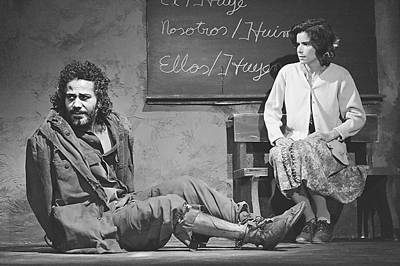Revisiting the myth as a man
The fictionalization of history to create drama is a convention as old as the theater itself. Aeschylus did it; Shakespeare, too—not to mention countless others. Their stories are designed to serve the political climate of their times rather than the truth. The ends––whether to reinforce man’s relationship to the gods or the primacy of the English monarchy in times of war––are much more important than the means as a good show beats historical accuracy every time.
Generally, in these undertakings the characters are writ large, as their heroic actions or dastardly doings are intended as object lessons for the contemporary audience. Shakespeare and his fellows spend just enough time on the personal stories to establish the characters as human, but that’s not the focus of the piece.
In our time when the world can wait with bated breath for a first look at a celebrity’s baby or salivate over details of the personal lives of anorexic actresses, writ small is the order of our day. Mostly it’s dull as can be, but sometimes, getting up close and personal can create compelling, if not perfect, theater.
That’s the case with “School of the Americas,” now at The Public in a co-production with LAByrinth Theater Company. The questionable hero is Che Guevara, whom we meet two days before his execution, imprisoned in a school in the Bolivian jungle. The sole teacher of the school insists on being allowed to speak with him, and for some reason she is permitted to do so. That much is fact. The rest has been imagined by playwright José Rivera, who is no stranger to Che, having written the screenplay for “The Motorcycle Diaries,” the film that reflected on Guevara’s idealistic beginnings.
What Rivera gives us is a portrait of a man who feels the crumbling of his ideology, and his frustration. He calls himself “a small, failed, stupid man,” as he opens up to Julia, the schoolteacher over two conversations. Clearly, this is not the Che lionized on T-shirts by college students who fancy themselves as rebellious outsiders. Rivera almost gleefully sticks a pin in the myth and deflates the icon to a more human size. He posits a level of introspection that is fairly implausible peppered with talk of the weather and grammar, and were it not for Rivera’s lyricism, this would be a fairly conventional play—“Sunset Boulevard” without the faded glamour and big house. As it is, it’s intriguing and the dynamic between the simple schoolteacher and the world famous outlaw no one knows what to do with takes on a poetic character—the simple connection between two people.
John Ortiz, who is also one of the artistic directors of LAByrinth, plays Che. He is bedraggled and beaten and spends almost the entire performance on the floor. His performance is often overwrought and his diction at times blurry, making his speeches hard to follow. Nonetheless, there is an inherent honesty to the broken but defiant man that makes it a worthy performance. Far more interesting is Patricia Velasquez as Julia Cortes. Perhaps because he was not tackling a myth, or had less to go on, Rivera makes her a more fully realized character—a woman trapped in her small town, too intelligent and passionate by half for those around her.
The set by Andromache Chalfant expresses the decay and claustrophobia of the village, and the lighting by David Weiner is extraordinary. Weiner captures the oppressive heat of the country, juxtaposed against the filtered darkness of the schoolroom. It’s a balance that underscores the tenuousness of the narrative brilliantly.
Director Mark Wing-Davey has done a good job of balancing the energies between the characters and maintains an air of menace around the outside world from which Che and Julia get only a minor respite. The overall effect is unsettling and slightly disturbing, but at the same time, there is the sense that even the most overblown political figure must someday confront his humanity. One can only hope that this part of the script is not a fabrication.
gaycitynews.com


































